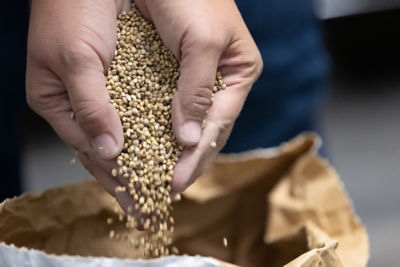The mode of action (MOA) of a fungicide indicates how the fungicide works to eliminate or inhibit pathogens. From a biological perspective, most fungicides work by inhibiting the germination of fungal spores or inhibiting the growth of fungal hyphae (strands that make up the body of the fungus). The Fungicide Resistance Action Committee (FRAC) classifies fungicides into MOA classes, and it assigns FRAC codes to classes or class subgroups based on the physiological mechanisms by which they affect fungi, including interfering with respiration and energy production, inhibiting nucleic acid and protein synthesis, and inhibiting enzyme functions. A fungicide’s specific MOA determines which pathogens will be affected by that fungicide.1,2
FRAC Code 3 – DMI Fungicides
The FRAC code 3 fungicides are the demethylation inhibitors (DMIs), which are a subgroup of the sterol biosynthesis inhibitor (SBI) fungicides. The DMIs were first introduced in the 1970s and now include fungicides with a broad spectrum of activity against a wide range of fungal pathogens, including powdery mildew, rust, and leaf spot pathogens. They work by inhibiting the production of the sterol compound ergosterol, a molecule used in fungal cells, which results in abnormal fungal growth. Some DMIs can also inhibit spore germination to some extent.3,4 They are locally systemic, absorbed into leaves, but may not move from leaf to leaf and do not move downward in the plant. DMI fungicides can have both preventative (protectant) and curative activities. The risk of pathogens developing resistance to DMIs is moderately high.5,6 Fungicide active ingredients in this group include cyproconazole, difenconazole, flutriafol, propiconazole, metconazole, tebuconazole, and tetraconazole.
FRAC Code 4 – Phenylamide Fungicides
Phenylamide fungicides (FRAC code 4) have broad-spectrum activity specifically against oomycete pathogens, including species of Phytophthora, Pythium, and the downy mildew pathogens. The phenylamides work by inhibiting RNA synthesis, which results in inhibited mycelial growth and spore (sporangia) formation. Most of these fungicides are upwardly systemic. The risk of some genera of pathogens developing resistance to phenylamide fugicides is high. Fungicide active ingredients in this group include metalaxyl and mefenoxam.4,6,7
FRAC Code 7 – SDHI Fungicides
The succinate dehydrogenase inhibitor (SDHI) fungicides (FRAC code 7) are a diverse group with varying ranges (spectra) of activity. The group includes fungicides with relatively narrow spectra of activity, such as carboxin, which is effective against some basidiomycete fungi. Other fungicides in the group are effective against a broad range of pathogens, such as boscalid, which is effective against both ascomycete and basidiomycete pathogens. SDHI fungicides work by inhibiting respiration (energy production) in fungal cells. They are usually locally systemic with translaminar movement and some upward mobility in the plant.4,5,7 SDHI fungicides are mostly preventative (protectant) and inhibit spore germination, but some also have curative activity. There is a moderate to high risk of pathogens developing resistance to SDHI fungicides.5,6,7 There are a large number of active ingredients in this group, including carboxin, boscalid, fluopyram, and penflufen.6,7
FRAC Code 11 – QoI Fungicides
The quinone outside inhibitor (QoI) fungicides (FRAC code 11) are broad spectrum, effective against ascomycete, basidiomycete, and oomycete pathogens. The MOA of the QoI fungicides inhibits fungal mitochondrial respiration, stopping energy production. This results in the inhibition of spore germination and early hyphal growth.4,7,8 The QoI fungicides are locally systemic to upwardly systemic. They can accumulate in the waxy cuticle layer on leaf surfaces and have preventative activity but limited to no curative activity. There is a moderate to high risk of pathogens developing resistance to QoI fungicides. This group includes the strobilurin fungicides, such as azoxystrobin, fluoxastrobin, picoxystrobin, pyraclostrobin, and trifloxystrobin.5,6,8
FRAC Code 12 – Phenylpyrrol Fungicides
The phenylpyrrole (PP) fungicides (FRAC code 12) have activity against ascomycete and basidiomycete pathogens. This group includes the fungicide fludioxonil, used primarily in seed treatments and in some foliar applications. These fungicides are thought to affect the osmotic regulation of fungal cells, but the specific mode of action is not well understood. Phenylpyrroles can inhibit spore germination and mycelial growth. There is no systemic movement of these fungicides within the plant. The risk of pathogens developing resistance to phenylpyrroles is low to medium.4,6,7
FRAC Code 22 – Benzamide and Thiazole Carboxamides Fungicides
The benzamide and thiazole carboxamide fungicides (FRAC code 22) primarily target oomycete pathogens. They work by disrupting the process of cell division, and they inhibit the growth of spore germ tubes and mycelium. They have preventative activity against pathogens and have no systemic movement within the plant. The risk of pathogens developing resistance to this group is low to medium. Zoxamide and ethaboxam are members of this group.4,6
FRAC Code 27 – Cyanoacetamide-oxime
Cymoxanil is the only fungicide in the cyanoacetamide group (FRAC code 27) that is currently registered for use on agricultural crops. This fungicide is active against oomycete pathogens, including the downy mildews, Phytophthora infestans (the cause of late blight of potatoes and tomatoes), and Albugo candida (the white rust pathogen). The MOA for this group is currently unknown, but the fungicide has preventative activity and some early infection activity. There is a low to medium risk of pathogens developing resistance to this group of fungicides.4,6
FRAC Code 28 – Carbamate Fungicides
Propamocarb is currently the only fungicide in the carbamate group (FRAC code 28) available for use on agricultural crops. Propamocarb is active against oomycete pathogens, including species of Pythium causing root rots and seedling diseases, Phytophthora capsici and Phytophthora infestans, and the downy mildew pathogens. It also is used to help manage early blight, caused by Alternaria solani (an ascomycete fungus) on potato and tomato. This group of fungicides work by interfering with the production of phospholipids and fatty acids used in cell membrane formation. This action results in the disruption of mycelial growth, spore production, and spore germination. Propamocarb is taken up by the roots and the leaves and is upwardly mobile in the plant. There is a low to medium risk of pathogens developing resistance to carbamate fungicides.4,6
FRAC Code 40 – CAA fungicides
The carboxylic acid amide (CAA) fungicides (FRAC code 40) are active against Phytophthora species (including P. infestans and P. capsici) and downy mildew pathogens. However, they are not effective against other oomycete pathogens such as species of Pythium. They have preventative activity and are most effective when applied before infection takes place. However, they have some curative activity as well. These fungicides inhibit cellulose synthesis, which disrupts cell wall formation. They inhibit mycelial growth and the germination of cystospores and sporangia but not zoospores. They are locally systemic with translaminar movement and upward mobility. The risk of pathogens developing resistance to CAA fungicides is low to medium. The group includes the active ingredients dimethomorph and mandipropamid.4,6,7
FRAC Code 49 – OSBPI Fungicides
The oxysterol binding protein homologue inhibition (OSBPI) fungicides (FRAC code 49) have activity against oomycete pathogens, including the downy mildews, Pythium ultimum, and species of Phytophthora. The mode of action is associated with the oxysterol binding protein but has not been well characterized. These fungicides are upwardly systemic with translaminar movement. The risk of pathogens developing resistance to OSBPI fungicides is medium to high. The active ingredient oxythiapiprolin is a member of this fungicide group.6,10
FRAC Code P 07 – Phosphonate Fungicides
The FRAC designation for the phosphonate fungicides used to be FRAC code 33, but that designation was recently changed to FRAC code P 07. This group of fungicides has activity against fungal and oomycete pathogens. These fungicides are primarily used as protectants, but they may have some activity against early infections. They work by inhibiting spore germination and mycelial growth. These fungicides are somewhat unusual because they are both upwardly and downwardly systemic. There is a low risk of pathogens developing resistance to phosphonate fungicides. This group includes fosetyl-Al, potassium phosphite, and other phosphorous acids and salts.4,6 Always read the most current labels for fungicide products and follow all recommendations and restrictions for their use.
SOURCES
1 Matheron, M. 2001. Modes of action for plant disease management chemistries. University of Arizona Cooperative Extension. https://cales.arizona.edu/crop/diseases/papers/dischemistry.html.
2 McGrath, M.T. 2004. What are fungicides? The Plant Health Instructor. DOI: 10.1094/ PHI-I-2004-0825-01. Updated 2016.
3 SBI Fungicides: Introduction and general information. FRAC Fungicide Resistance Action Committee. https://www.frac.info/frac-teams/working-groups/sbi-fungicides/information.
4 Mueller, D., Wise, K., Dufault, N., Bradley, C., and Chilvers, M. (Eds.) 2013. Fungicides for field crops. The American Phytopathological Society. 5 2021. Fungicide modes of action. Bayer Crop Science Canada. https://www.cropscience.bayer.ca/en/articles/2021/fungicide-modes-of-action.
6 FRAC Code List© 2024: Fungal control agents sorted by cross-resistance pattern and mode of action. FRAC Fungicide Resistance Action Committee. https://www.frac.info/home.
7 Stevenson, K., McGrath, M., and Wyenandt, C. (Eds.) 2019. Fungicide resistance in North America. The American Phytopathological Society.
8 Robertson, A. and Mueller, D. 2019. Preventative and curative fungicides. Iowa State University, Integrated Crop Management. https://crops.extension.iastate.edu/blog/alison-robertson-daren-s-mueller/preventative-andcurative-fungicides.
9 Kuhn, P., Tally, A., and Druebbisch, B. 2015. Oxathiapiprolin, a new fungicide active ingredient for control of diseases caused by oomycetes. Phytopathology 105(11):S4.76.
Websites verified 3/28/2024
ADDITIONAL INFORMATION
For additional agronomic information, please contact your local seed representative. Performance may vary, from location to location and from year to year, as local growing, soil and environmental conditions may vary. Growers should evaluate data from multiple locations and years whenever possible and should consider the impacts of these conditions on their growing environment. The recommendations in this article are based upon information obtained from the cited sources and should be used as a quick reference for information about vegetable production. The content of this article should not be substituted for the professional opinion of a producer, grower, agronomist, pathologist and similar professional dealing with vegetable crops.
BAYER GROUP DOES NOT WARRANT THE ACCURACY OF ANY INFORMATION OR TECHNICAL ADVICE PROVIDED HEREIN AND DISCLAIMS ALL LIABILITY FOR ANY CLAIM INVOLVING SUCH INFORMATION OR ADVICE.
5026_379938 Published 04/26/2024




